Resources
Project EverGreen is passionate about the importance of green spaces
We want you to be just as excited about the benefits communities experience from well-maintained yards, parks and green spaces. Research shows a multitude of environmental, economic and lifestyle benefits. Explore our resources and learn great things about why green matters.
The Health and Wellness Benefits of Green Spaces Infographic
 Green Spaces Health and Wellness Infographic
Green Spaces Health and Wellness Infographic
Green spaces deliver numerous health and wellness benefits to communities across the country. From encouraging community well-being and protecting mental health to absorbing heat and creating fresh air, green spaces are the lungs of a city.
Project EverGreen’s GreenCare for Communities projects revitalize urban green spaces, connect neighborhood residents and emphasize the significant value green spaces provide.
Know Your Green Spaces Facts
Know Your Green Spaces and discover why green spaces are such an important part of your community with these ready-to-post social graphics.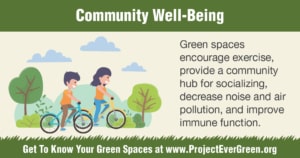
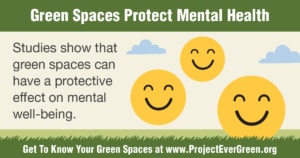
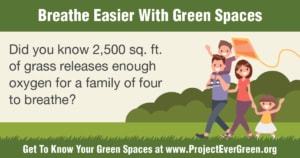
What is a Green Space?
 A green space is an area of grass, trees or vegetation that connects people with the amazing benefits of Planet Earth. Whether the green space is to observe, enjoy recreation or relax, these areas improve the world around us. Green spaces especially help improve quality of life in urban environments, enabling more people to connect with one another, engage in healthy activities, breath more fresh air and enjoy cooler spaces.
A green space is an area of grass, trees or vegetation that connects people with the amazing benefits of Planet Earth. Whether the green space is to observe, enjoy recreation or relax, these areas improve the world around us. Green spaces especially help improve quality of life in urban environments, enabling more people to connect with one another, engage in healthy activities, breath more fresh air and enjoy cooler spaces.
Consider these facts about the benefits of green spaces:
- Just 2,500 square feet of turf releases enough oxygen for a family of four to breathe
- Grass is 14 degrees cooler than bare soil and 30 degrees cooler than asphalt
- Green space gathering places lead to safer, closer-knit communities
- Physically active young people demonstrate higher academic performance at school
- Spending even a short time in nature creates a greater sense of well-being
Project EverGreen has renovated more than 50 million square feet of public green spaces. That’s enough oxygen for 20,000 families of four!
Lifestyle Benefits of Green Spaces
Imagine your local park completely devoid of green. It’s not a pretty picture. It’s easy to take for granted the importance of green spaces in our lives. Project EverGreen has compiled some interesting research that shows the lifestyle benefits of green spaces.
 Privacy and tranquility. Well-placed plantings offer privacy and tranquility by screening out busy street noises and reducing glare from headlights.
Privacy and tranquility. Well-placed plantings offer privacy and tranquility by screening out busy street noises and reducing glare from headlights.
Lower crime and enhanced self esteem. Studies over a 30-year period in communities, neighborhoods,housing projects and prisons show that when landscaping projects are promoted there is a definite increase in self esteem and a decrease in vandalism.
Stress reduction. A study published in Environment and Behavior (Vol35:311.330)indicates that“…by boosting children’s attentional resources, green spaces may enable them to think more clearly and cope more effectively with life’s stress.”
Green space is beneficial to children. Studying the effects of green space, a Cornell University researcher indicated that “children who had the greatest gains in terms of ‘greenness’ between their old and new homes showed the greatest improvements in functioning.”
Girls & greenery. A University of Illinois study found that girls exposed to green settings are better able to handle peer pressure, sexual pressure and other challenging situations as well as perform better in school.
Health benefits. There is growing evidence that horticulture is important on a human level. Plants lower blood pressure, reduce muscle tension related to stress, improve attention and reduce feelings of fear and anger or aggression.
Good landscaping increases community appeal. Parks and street trees have been found to be second only to education in residents’ perceived value of municipal services offered. Psychologist Rachel Kaplan found trees, well-landscaped grounds and places for taking walks to be among the most important factors considered when individuals chose a place to live.
Green spaces create communities. Studies conducted by the Human Environment Research Laboratory at the University of Illinois Urbana-Champaign indicate that “Green spaces are gathering places that create close-knit communities and improve well-being—and in doing so, they increase safety.”
Better atmosphere for learning. To test attentiveness, a university class rotated between 2 classrooms.One contained plants and foliage and one did not. Results at the end of the academic year showed inattentiveness was reduced by 70 percent in the room containing plants plus indications of better exam performance.
Health benefits in children. Researchers found that Attention Deficit Disorder(A.D.D.) symptoms in children are relieved after contact with nature. Greenery in a child’s everyday environment—even views of green through a window—reduces ADD symptoms.
Safer neighborhoods. In a study conducted at a Chicago public housing development, residents of buildings with more trees and grass reported that they knew their neighbors better, socialized with them more often, had stronger feelings of community and felt safer and better adjusted than did residents of more barren, but otherwise identical buildings.11
Mood enhancer. Gardening and yard work contribute to healthy, active living both physically and emotionally. Horticulture therapists have discovered that gardening provides a form of emotiona lexpression and release, and it helps people connect with others.
Road rage reduction. An interesting effect found in recent studies on driving and road stress is called the “immunization effect”—the degree of negative response to a stressful experience is less if a view of nature preceded the stressful situation.
Social communities strengthened. Trees have the potential to reduce social service budgets,decrease police calls for domestic violence, strengthen urban communities and decrease the incidence of child abuse.
Reduced recovery time. Doctors have shown that people recover faster in a hospital when given a landscape view, rather than seeing only the walls of adjoining buildings.
Download these benefits and their sources: Lifestyle Benefits Fact Sheet
Environmental Benefits of Green Spaces
Green spaces are a great benefit to our environment. They filter pollutants and dust from the air, they provide shade and lower temperatures in urban areas, and they even reduce erosion of soil into our waterways. These are just a few of the environmental benefits that green spaces provide.
 Urban advantages. More green space within a city’s boundaries can improve the urban environment. Among the green space advantages listed in EcoPlanIT Madison: Green Space Goal (UW-Madison Department of Urban and Regional Planning) are: helping regulate air quality and climate…reducing energy consumption by countering the warming effects of paved surfaces….recharging groundwater supplies and protecting lakes and streams from polluted runoff.
Urban advantages. More green space within a city’s boundaries can improve the urban environment. Among the green space advantages listed in EcoPlanIT Madison: Green Space Goal (UW-Madison Department of Urban and Regional Planning) are: helping regulate air quality and climate…reducing energy consumption by countering the warming effects of paved surfaces….recharging groundwater supplies and protecting lakes and streams from polluted runoff.
Water quality protection. Proper landscaping reduces nitrate leaching from the soil into the water supply and reduces surface water runoff, keeping phosphorus and other pollutants out of our waterways and preventing septic system overload.
Reduced heat buildup. Trees in a parking lot can reduce on-site heat buildup, decrease runoff and enhance night time cool downs. Tests in a mall parking lot in Huntsville, Ala. showed a 31 degree difference between shaded and unshaded areas.
Reduced soil erosion. A dense cover of plants and mulch holds soil in place, keeping sediment out of lakes, streams, storm drains and roads; and reducing flooding, mudslides and dust storms.
Improved air quality. Trees, shrubs and turf remove smoke, dust and other pollutants from the air. One tree can remove 26 pounds of carbon dioxide from the atmosphere annually, equaling 11,000 miles of car emissions. One study showed that one acre of trees has the ability to remove 13 tons of particles and gases annually. 2,500 square feet of turf absorbs carbon dioxide from the atmosphere and releases enough oxygen for a family of four to breathe.
Lower attic temperatures. Trees shading homes can reduce attic temperatures as much as 40 degrees. According to the EPA, urban forests reduce urban air temperatures significantly by shading heat sinks such as buildings and concrete and returning humidity to the air through evaporative cooling.
Natural resource conservation. By using trees to modify temperatures, the amount of fossil fuels used for cooling and heating is reduced. Properly placed deciduous trees reduce house temperatures in the summer, allowing air conditioning units to run 2 to 4 percent more efficiently. The trees also allow the sun to warm the house in the winter.
Green roofs cool urban hot spots. Led by cities such as Chicago and Toronto, as well as a number of universities, evidence is mounting that green roofs (i.e. roofs totally or partially covered with vegetation) can play an important role in saving energy, reducing the urban heat island effect and adding more green space to a built environment.
Cooler summer days. Lawns will be 30 degrees cooler than asphalt and 14 degrees cooler than bare soil in the heat of summer.
Natural resource conservation. Homeowners can “grasscycle” by leaving grass clippings on the lawn when mowing. The clippings quickly decompose and release valuable nutrients back into the soil to feed the grass, reducing the need for nitrogen by 25 to 50 percent. Modern mulching lawn mowers make “grasscycling” even easier, and homeowners can reduce their mowing time by 30 to 40 percent by not having to bag clippings.
**Reduced pollution. ** Trees naturally remove pollutants from the air, so every tree that’s subtracted from a city’s ecosystem means some particulate pollution remains that should have been filtered out. In Washington, that amounts to 540 extra tons each year.
Rainfall retention. A healthy, sodded lawn absorbs rainfall 6 times more effectively than a wheat field and 4 times better than a hay field.
**Natural storm water management. **A big tree removes 60 to 70 times the pollution than a small tree.
Reduced temperatures. In Atlanta, temperatures have climbed 5 to 8 degrees higher than surrounding countryside where developers bulldozed 380,000 acres between 1973 and 1999, according to NASA. Scientists fear the heavily developed corridor between Boston and Washington could be the next big hot zone.
Download these benefits and their sources: Environmental Benefits Fact Sheet
Economic Benefits of Green Spaces
Green spaces benefit the economy in many ways. Studies have found that employees are more productive when working around interior plants, and that hospital patients recover faster when they have a view of green space.
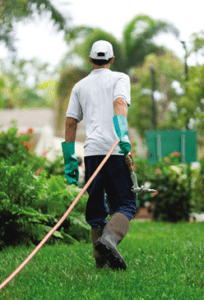 Green space can improve property value. This has been documented in a number of publications and studies including:
Green space can improve property value. This has been documented in a number of publications and studies including:
- Smart Money Magazine indicated that consumers value a landscaped home up to 11.3 percent higher than its base price.
- A study by Aspen Environmental Companies found that a landscaping investment is nearly always recovered and can help reduce time on the market.
- Money Magazine says: “attractively landscaping your yard can be one of the most cost-effective ways to boost your home’s curb appeal,” and emphasizes the value added by trees.
- In Canada, researchers at Quebec’s Laval University created a detailed survey study of 760 home sales and found that landscaping attributes (trees, flowers, plants, hedges) can “command a substantial market premium.”
Fast growth, major economic impact. According to a USDA-funded research report, the environmental horticulture industry [Green Industry], “is one of the fastest growing segments of the nation’s agricultural economy.” Its economic impact was estimated to include: $147.8 billion in output, $64.3 billion in labor income, $6.9 billion in indirect business taxes, 1,964,339 jobs $95.1 billion in value added.
Businesses benefit. Roadside Studies by the University of Washington stated that drivers indicated it was easier to locate roadside businesses when they were framed by trees and vegetation, rather than having this green material removed.
Parks improve property value. There is a significant link between the value of a property and its proximity to parks, greenbelts and other green spaces. Studies of three neighborhoods in Boulder, Colo. indicated that property values decreased by $4.20 for each foot away from a greenbelt.
Green space helps decrease air conditioning costs. Here are some useful references: According to the California Energy Commission: “Planting the correct trees, shrubs, vines and groundcover can make your home both warmer in the winter and cooler in the summer. In fact, the right type of tree can reduce your summer cooling costs by 20 to 40 percent!” Computer models devised by the U.S. Department of Energy predict that the proper placement of only three trees will save an average household between $100 and $250 in energy costs annually. The cooling effect of an average size lawn is equal to about 9 tons of air conditioning.
Views of plants increase job satisfaction. Employees with an outside view of plants experience less job pressure and greater job satisfaction than workers viewing man-made objects or having no outside view. They also report fewer headaches and other ailments than workers without the view.
Nature increases worker productivity. Psychologists have found that access to plants and green spaces provides a sense of rest and allows workers to be more productive.
Landscaping renews business districts. Greening of business districts increases community pride and positive perception of an area, drawing customers to the businesses.
Quality landscaping means quality goods. A recent study found that consumers would be willing to pay, on average, a 12% premium for goods purchased in retail establishments that are accompanied by quality landscaping.
Employment and tourism boost. Employment opportunities are associated with the creation and long term maintenance of urban open space, as well as tourism dollars of visitors from parks, gardens and civic areas (Woolley 2003).
Increases retail activity. Studies have proven that greenery and flowers attract shoppers and residents to urban areas…spurring economic growth.
Business growth. Small businesses choosing a new business location rank the amount of open space and proximity to parks and recreation as the number-one priority in site selection.
Protects drainage systems. The crown of a large tree is a freestanding anti-flood reservoir, in some cases intercepting so much rainfall that more than 1,500 gallons a year evaporates instead of hitting the ground. Chop down the tree, and you increase the volume of storm water a city must manage— something that especially affects older cities with aging drainage systems.
Download these benefits and their sources: Economic Benefits Fact Sheet
5 Ways to Improve Your Green Space
No matter what the climate or situation, every homeowner can enjoy the environmental, economic and lifestyle benefits that come from caring from your lawn and landscape. Proper care of trees, grass and shrubs is surprisingly simple, and its rewards are numerous on both a personal and community level.
Here are five quick tips for maximizing the benefits of your green space:
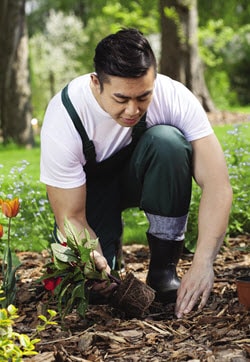 1. Take care of your grass. While this may seem like an obvious piece of advice, it’s often overlooked. Taking care of your own front yard is a good first step toward protecting and maintaining your green space. Lawns play a major role in protecting ground water by reducing runoff, thus preventing soil erosion, maintaining soil permeability and conserving water. Lawns also provide an extension of your overall living space, and for many families they become an enjoyable private oasis.
1. Take care of your grass. While this may seem like an obvious piece of advice, it’s often overlooked. Taking care of your own front yard is a good first step toward protecting and maintaining your green space. Lawns play a major role in protecting ground water by reducing runoff, thus preventing soil erosion, maintaining soil permeability and conserving water. Lawns also provide an extension of your overall living space, and for many families they become an enjoyable private oasis.
2. Choose flowers and plants that suit your area’s climate. It’s imperative to choose plants and flowers that tolerate your area’s climate. Choosing the correct plants will ensure a beautiful garden year after year and make the job of caring for your plants much easier. Having a beautiful green space has also been known to lower blood pressure, reduce muscle tension, improve attention spans and reduce feelings of fear and aggression.
3. Prune, prune, prune. Pruning is important to maintain your flowers, plants and shrubs year after year, but it also needs to be done correctly. Improper pruning can actually be more harmful than neglecting to prune completely. Proper pruning will produce better blooms, maintain a plant’s desired size, and can even rejuvenate an older shrub. Having well-maintained flowers and shrubs will not only make your green space more attractive, but it will also provide a protective habitat for birds and other creatures that serve to enhance the natural beauty of your outdoor living space.
4. Enrich your soil with a compost pile. Who knew those old coffee grounds, filters and dryer lint could be the golden ticket to creating a beautiful green space? These types of materials, combined with yard clippings, wood chips and leaves, regenerate your soil. The breakdown of these materials creates humus, which is a nutrient-filled material, helping the soil to retain moisture. Compost can also cut down on plant disease and repel pests that are damaging to your yard. Creating a compost pile will not only provide rich nutrients that your soil needs, but it also helps the environment by cutting back on landfill waste, thus extending the life of the landfill.
5. Plant a tree. Planting a tree is one of the most simple and effective activities you can perform to improve your green space. In areas of new construction, many neighborhoods start out virtually treeless. The results include high cooling costs, less oxygen and more pollutants. There are many trees that are inexpensive and fast-growing. In fact, some can grow up to 12’ per year, quickly reversing the effects of new construction. Trees not only help to keep the heat out of the house, but they also cool the outside temperature around your home as well. A study in Huntsville, Ala. showed a 31-degree difference between the shaded and unshaded areas of a parking lot. By using trees to modify temperatures, the amount of fossil fuels used for cooling and heating is reduced.
Download these tips: 5 Ways to Improve Green Spaces
Designing the Perfect Backyard Green Space
Landscaping is an art form, requiring planning, knowledge, and hard work. It entails a whole lot more than going to the local nursery, picking a couple of plants that look nice, digging some holes, and calling it a job done.
Before you start a landscape project, you need to answer some basic questions that will help you pick the right plant and put it in the right place. Project EverGreen asked the pros at Spring-Green lawn care services, a long-time supporter of PE and advocate for green spaces, for tips on how to design the ideal backyard green space for your family to enjoy.
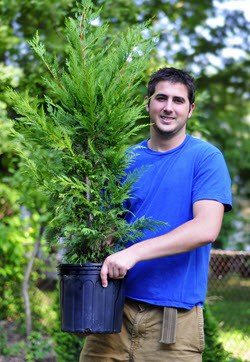 Starting Your Landscape Plan
Starting Your Landscape Plan
First, you need to decide the basic layout and space available for the trees and shrubs you are going to buy. Take a survey of your property and make a drawing of the shape of your property.
Draw in the location of your house, driveway, sidewalks, and any other permanent structures. It is a good idea to try to determine the slope of your property and note any areas of your yard that may be influenced by surrounding structures or plants. An example of this would be the amount of shade coming from a neighbor’s trees.
Sketch some ideas on paper to get an idea where you may want to add new plants, or replace old ones. On the layout, it would be a good idea to pencil in the location of the windows on your house; determine the distance from the window to the ground level; and write it underneath each window sketched. This information will be useful when choosing foundation plants.
Picking Landscape Plants
Second, you need to decide why you are planting what you are planting. Is it going to be a focal point of the entire landscape, or is it going to be used to fill in an open space? Are you purchasing it for its beauty and looks, or will it be functional, such as a border or hedge, or both?
Do some research by looking at landscape guides, garden magazines, or by visiting a local nursery or garden center. It is important to know the ultimate height and/or width of the trees and shrubs you are considering.
One common mistake that many do-it-yourselfers make is putting too many plants in too small of a place. Another common mistake is not considering the height or width of the plant. If the window is 3 feet from the ground and the plant you purchase will grow to 10 feet, there will be a shrub care problem in a very short time.
The same holds true when placing plants next to a door. If the plant will grow to a width of 8 feet and it is planted 2 feet from the front door, then it may soon become difficult to find the door. It can be deceiving when you go to purchase a plant that is only 24-inches wide and try to envision it at its full size. It is important to keep this in mind, or you may be redoing your landscape every 10 years, or so.
Placing Landscape Plants
The third consideration is the placement of the plants in relationship to the growing and maintenance conditions of the planting site and the growing requirements of the plant itself. An example of this is putting shade loving plants in shady yard areas and sun-loving plants in sunny yard areas.
Remember to consider the potential size of the surrounding plants. Finally, consider the aesthetic value and appeal of the plants you are choosing. You need to decide what looks good to you.
You could hire a landscape architect to make many of the decisions for you and offer suggestions for plant selections. Those services will cost extra money, but it may be worth it if you are at your wit’s end deciding which plants to choose.
Download these tips: Designing the Perfect Green Space
Community Playbook
 Project EverGreen, a national non-profit organization, originated the concept of an EverGreen Zone, now called GreenCare for Communities, in 2008 in Akron, OH. It added Milwaukee in 2009, while continuing the effort in Akron. It added the area from Raleigh-Durham to Greensboro-Winston Salem in North Carolina in 2010.
Project EverGreen, a national non-profit organization, originated the concept of an EverGreen Zone, now called GreenCare for Communities, in 2008 in Akron, OH. It added Milwaukee in 2009, while continuing the effort in Akron. It added the area from Raleigh-Durham to Greensboro-Winston Salem in North Carolina in 2010.
Because funding limitations prevent Project EverGreen from implementing GreenCare for Communities in every city of America, this “playbook” is designed for local green industry organizations to engage their community in a public education campaign on their own. The playbook outlines how to conduct a GreenCare for Communities campaign from start to finish.
Download this tool: GreenCare for Communities Playbook
Our View of Sustainability
 Sustainability is an ideal. It’s a race without a finish line, and defining the term can be difficult, even among the many members of Project EverGreen.
Sustainability is an ideal. It’s a race without a finish line, and defining the term can be difficult, even among the many members of Project EverGreen.
But here’s what we can all agree on: sustainability means we’re leaving the planet, our communities and our environment better than when we found it. It means we’re building companies that are responsible for planting thousands of trees, millions of flowers and acres of cool, refreshing green spaces. We create environments that bring families, neighbors, and people of all sorts together. We build communities by shaping the natural world in such a way that our neighbors today, and future generations will look around and say, ‘what a beautiful place this is.’
The intent of this landing page on sustainability from Project EverGreen is to convey to our viewers what the Green Industry is doing with regard to creating and maintaining a sustainable environment – from our largest companies to the thousands of individual volunteers. This is a compendium of, for lack of a better term, “sustainability plans” by companies, associations and individuals that are designed to educate and enlighten visitors who review our website on the many lasting benefits of well-maintained green spaces..
We don’t intend to define sustainability. We’ll leave that to others. What we do want to do is give consumers an opportunity to see the depth and breath of the commitment by the Green Industry to create a sustainable environment for its customers and its employees.


